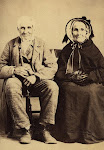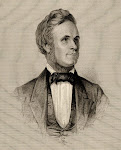In May, 1868, while the Neville-Stiffs were in New York preparing for the trip west, Brigham Young signed a contract with the Union Pacific Railroad. It was obvious with track going down many miles each day that it would be to Sal t Lake City by the following years. He had heard of the company problems with workers and knew he had a ready supply of good men in Utah who needed a little extra cash. Whether the railroad decided to build its track straight through Salt Lake City or not, this would be the men to do it.
When the decision was made to run the tracks northward through Ogden and then meet the Central Pacific in the Utah Desert west of there, Salt Lake citizens complained. At a mass meeting held on June 10, likely while the Neville-Stiffs were crowding themselves into the train car for their trip west, the railroad held firm to their decision and finalized plans to build the railroad tracks through Ogden, around the north end of the Great Salt Lake and toward California. Immediately three church members, Ezra T. Benson, Chauncey West and Lorin Farr signed a contract with the Central Pacific to build 200 miles of track from Humbolt Well, Nevada, eastward to Ogden. With Brigham’s contract to build westward from Echo Canyon 90 miles to Ogden, Utah was insured a reprieve from the violence and corruption which had been a part of the railroad crew up to that point.
Almost as soon as the Neville-Stiffs heaved their last sign at reaching Centerville, they heard of the contracts for building the railroad, and they lost not time signing up. Records no longer exist for which men worked on the railroad on these church crews, however, we know that the Stiffs worked on the line which ran from Echo to Ogden. The railroad had reached Evanston, the southwestern corner of Wyoming, in December, 1868. Linking several miles east of Evanston, hereafter it moved south and west to keep its rendezvous with the Central Pacific.
The route of the railroad through Echo Canyon in 1898 and 1869 was open country with no towns nearby. High cliffs rose on each side of the valleys, making a ringing echo every time a hammer was applied. The workers lived out there all week, returning home to spend Sunday with their families. Then Monday morning early they would load beans, oats and pork onto a wagon and return to the mountains to work. Work was hard. They graded and leveled with a wheel barrow and scoop shovel. They lived in tents, caves or just found shelter under an overhanging cliff. Fortunately for Rachel who was left alone, John and Annie and the children lived next door. At first William and his sons slept in a ten, but as time went on it was wearing out-probably was well worn already from the pioneer trail—and anyway they were tired of putting it up in a different ant hill every night.
One night Joseph Hyrum spotted an opening in the rocky hillside with an overhanging rock above it. “It’s a perfect shelter,” he said. “Let’s sleep up there.”
So his little group climbed up the reddish rocks to where the large overhanging rock projected out over a flat opening in which they could crawl and spread out their bedding. They ate supper at dusk and then climbed up to sleep in their little cave. The nigh was somewhat illuminated by the moon, and the stairs were clustered in the sky as they had never seen them in smoky England.
But under their overhanging rock they couldn’t see the stars. They couldn’t see the moon. They couldn’t see anything but the great looming shadow of that huge boulder on top of them. After a while Joseph spoke.
“Is anybody else awake?
“We’re awake. We can’t sleep.”
“I can’t either. I think it’s the thought of this 20-ton rock hanging over my head.”
“Maybe that’s our problem.”
Joseph sat up halfway so he wouldn’t bump his head. “I think I know what to do.” He got out of his bedding and walked out to where the moon and stars were again brightly shining. There by the light which now seemed brighter than ever because of the darkness to which he had been accustomed, he found a sturdy tree branch. It took him a while to saw it to the right length and whittle it to the exact size he needed.
“What are you doing, Joe?” came a voice from under the monolith.
“You’re about to see,” he replied. Putting away his tools, he brought up the stick to the cave. “I just thought if I wedged this branch into the opening here, it would hold up that rock and we could sleep.” He propped the stick from the floor to the ceiling of the cave.
“I’m not sure that would do it,” came a voice from the blankets.
“But still I think I’ll sleep better,” said Joseph. And he did.
In years to come the stick stayed in place. Whenever the family came that way they would see it up in the rocks, still holding up the great overhanging rock. “See,” Joseph would say, “It’s doing its job.”
After Joseph died, his grandson Leo noticed one day that the old stick was decaying. “Better fix that,” he said. Climbing up those same rocks his grandfather and great grandfather had climbed two generations before, he cut and wedged another stick into place. It remains there to this day, a small monument to a family that laughs while it works.
On March 8, the railroad was completed to Ogden where the workers were incorporated into a city wide celebration. At 5:00 p.m. banners were raised, speeches were made, and the workers may have had a bed to sleep in again. However, the big celebration was yet to come.
Railroad crews continued to lay tracks while Congress decided that they would join at Promontory, Utah. A celebration was planned, a golden spike make from 23 twenty dollar gold pieces was presented by California, a laurel wood railroad tie was fashioned in San Francisco with an inscribed silver plate. “The last tie laid on the completion of the Pacific Railroad, May 10, 1869,” and a spike of gold, silver, and iron was prepared by the state of Arizona. A brass band assembled to practice for the occasion.
The Neville-Stiff family was in the brass band. With all they had to do, they somehow found time to play instruments. And they somehow found instruments, or is it possible those instruments came with them in the handcart? Joseph Hyrum played the coronet and William played the bassoon. The driving of the Golden Spike was a celebration worth working for and they never forgot it. The excitement of having been there sassed down to the present generation. These were people who laughed while they worked and then came home to play music.
After the railroad contract was completed, Joseph set up business in Salt Lake City. He was a good builder and knew he could do well there. William and Rachel lived in Centerville. Then one day something happened which would change the direction, or at least the location, of the family forever.
Brigham Young came to William H. Lee’s farm in Bountiful.
“William, you sure have a nice place here.”
William Lee had worked for Brigham Young since he and his family moved to Winter Quarters with the Church in 1847. He had established a settlement at cold and windy Fort Supply in Wyoming and went on several missions. He knew something was up this time too. “Brother Brigham, I doubt you came all this way to Davis County to tell me that.”
William was called to begin a settlement at Twelve Mile Creek in the Bear River Valley. Settlements had already been started in the northern end of the valley, Paris, St. Charles, Garden City and Randolph. However, since the railroad had come through, cattle ranchers had begun to go through the Bear River Valley where Randolph and Woodruff were established. President Young didn’t want this land to fall into the hands of the “gentiles”, and moved quickly to ensure it would remain friendly to the church.
The whole Neville-Stiff family was about to be caught up in the new adventure.
Saturday, October 27, 2012
Subscribe to:
Post Comments (Atom)









No comments:
Post a Comment